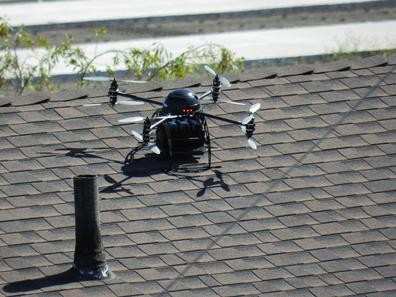Sun, May 15, 2011
Tiny Aircraft Has Extended Remote Landing Range, Reporting
Capability To Detect Occupancy In A Compound
The Phoenix50-H, a quad coaxial mini-copter system capable of
performing multiple functions such as detecting movement or
breathing of a hiding person in a compound from a sloped roof was
introduced Thursday by TiaLinx. The company develops remotely
controlled mini-unmanned aerial and ground vehicles which can be
integrated with ultra-wideband miniaturized radars. The company
says the mini-copter can be remotely controlled at extended
standoff distances of hundreds of feet from ground or an airborne
assets to keep the operators out of harm's way.

TiaLinx Image
The lightweight and agile mini-copter can be programmed to fly
to or land at multiple waypoints. It has been integrated with
TiaLinx's fine beam ultra-wideband (UWB), multi-Gigahertz radio
frequency (RF) sensor array. An onboard microphone and video camera
augment the sensor capability of Phoenix50-H. TiaLinx's advanced
real-time and lightweight UWB RF imaging system was an essential
step in the development of Phoenix50-H to operate at high
elevations for prolonged missions. The transmitted power of the UWB
signal is less than a typical cellular phone.
Through a software-controlled interface which is integrated into
a laptop or joystick controller unit, Phoenix50-H can be remotely
guided from extended distances to perform mission-critical tasks.
Innovations in mechanical design of the system allow for smooth
landing and take-off from sloped roofs. This advanced feature
allows for monitoring a premise under surveillance for enhanced
situational awareness or rescue operations of hard-to-access
buildings.
The ultra-lightweight RF Scanner is mounted on a lightweight
mini-copter and transmits wideband signals that are highly
directional and can penetrate roofs at an extended range. In the
receiver, a signal detector circuit is employed to capture the
reflections from targets. Amplitude and delay information are then
processed in an integrated signal processor.
System evaluations indicate that a remotely controlled system at
an extended range from an operator point of view is essential for
safety and completion of a critical mission. The introduction of
the Phoenix50-H's is intended to provide advanced miniaturized life
detection sensors in compounds and to keep the operators at least a
few hundred feet away.
More News
How To Get A Story On Aero-TV News/Feature Programming How do I submit a story idea or lead to Aero-TV? If you would like to submit a story idea or lead, please contact Jim Campbel>[...]
From 2011 (YouTube Edition): Aviation's Greatest Living Legend Talks About His Life In Aviation (Part 5, Final) ANN is pleased to offer you yet another snippet from the public conv>[...]
“All Air Traffic Controllers must get back to work, NOW!!! Anyone who doesn’t will be substantially ‘docked. For those Air Traffic Controllers who were GREAT PATR>[...]
Aero Linx: American Navion Society Welcome to the American Navion Society. Your society is here to support the Navion community. We are your source of technical and operating infor>[...]
Glideslope Intercept Altitude The published minimum altitude to intercept the glideslope in the intermediate segment of an instrument approach. Government charts use the lightning >[...]
 ANN FAQ: Contributing To Aero-TV
ANN FAQ: Contributing To Aero-TV Classic Aero-TV: Bob Hoover At Airventure -- Flight Test and Military Service
Classic Aero-TV: Bob Hoover At Airventure -- Flight Test and Military Service Aero-News: Quote of the Day (11.12.25)
Aero-News: Quote of the Day (11.12.25) ANN's Daily Aero-Linx (11.12.25)
ANN's Daily Aero-Linx (11.12.25) ANN's Daily Aero-Term (11.12.25): Glideslope Intercept Altitude
ANN's Daily Aero-Term (11.12.25): Glideslope Intercept Altitude



